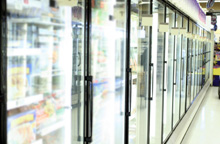History of freezing
The underdevelopment of primitive conditions for a long time did not make it possible to improve the primitive forms of preservation. Beyond making trials with snow and natural ice, one (Francis Bacon) realized that the salt solution also has chilling effect. At the end of the 17th century the Parisian lemonade and ice cream chilled with ice and salt mixture were famous.
Till the middle of the 19th century, until lower temperatures could be generated, only natural ice was used for chilling, which became a goods on the world market. Losses at transportation and storage as well as the contamination in ice, encouraged the development of the refrigerator.
The first refrigerator operating with ammoniac compressor was built in 1876 based on the plans of C. Linde. After building the refrigerator beyond chilling foods, the preservation with freezing also started.
The modern industry of frozen foods started with Clarence Birdseye in America in 1925, who was a fur trader in Labrador. He realized that the fish fillets which were left behind by the native people got frozen due to the arctic weather and they had better fresh taste than those ones which were frozen in other seasons on other temperature. The key in Birdseye discovery was the speed of freezing, so it started developing industrial machines which made the quick freezing of foods possible. Nowadays we know that due to quick freezing wide range of foods can preserve their nutritional value on a proper way.
The first generation of Greenfreeze refrigerators, commonly used in households, was introduced in 1992. The equipments do not use gases which damage the ozone layer and their energy consumption is lower, as well.

